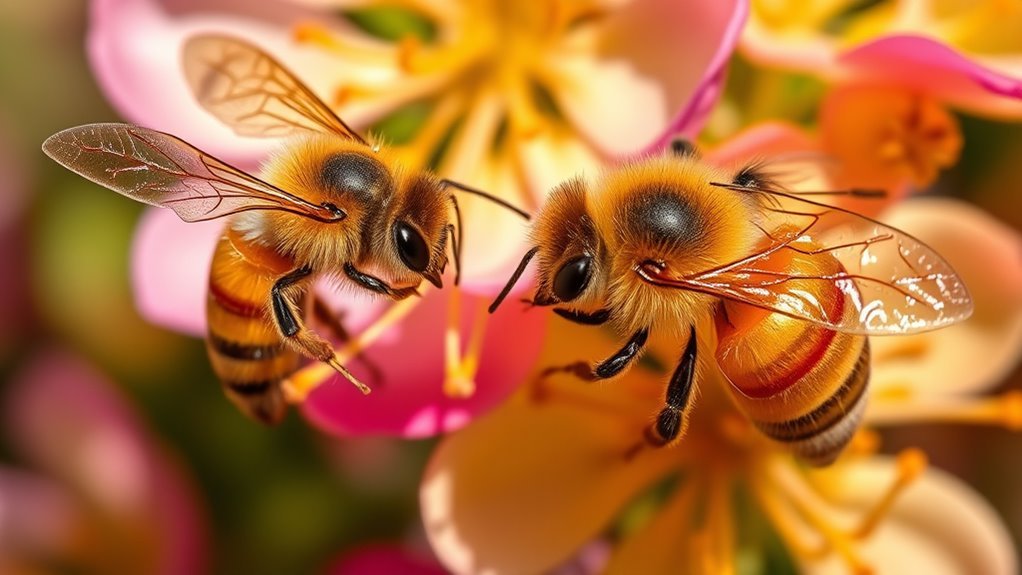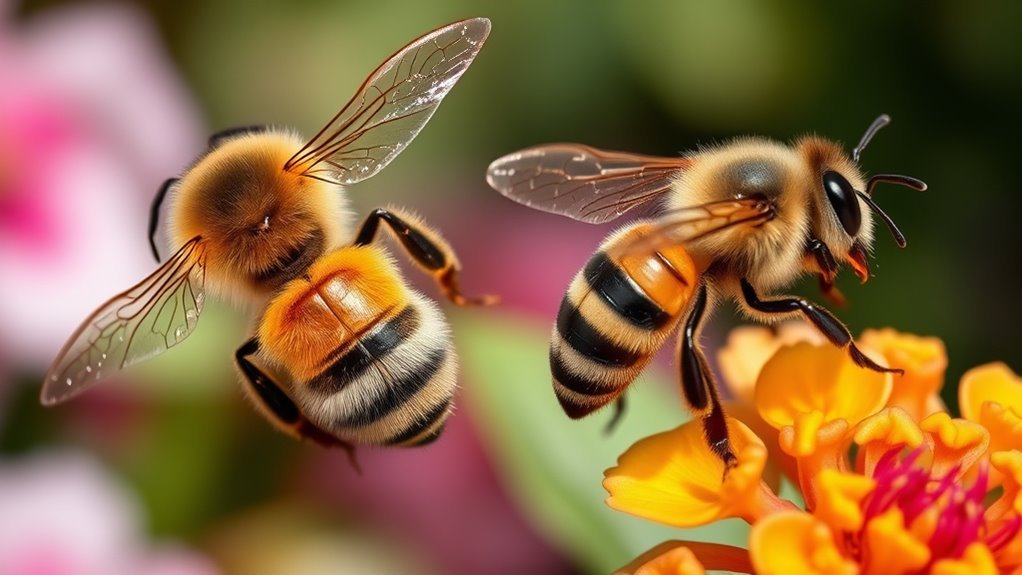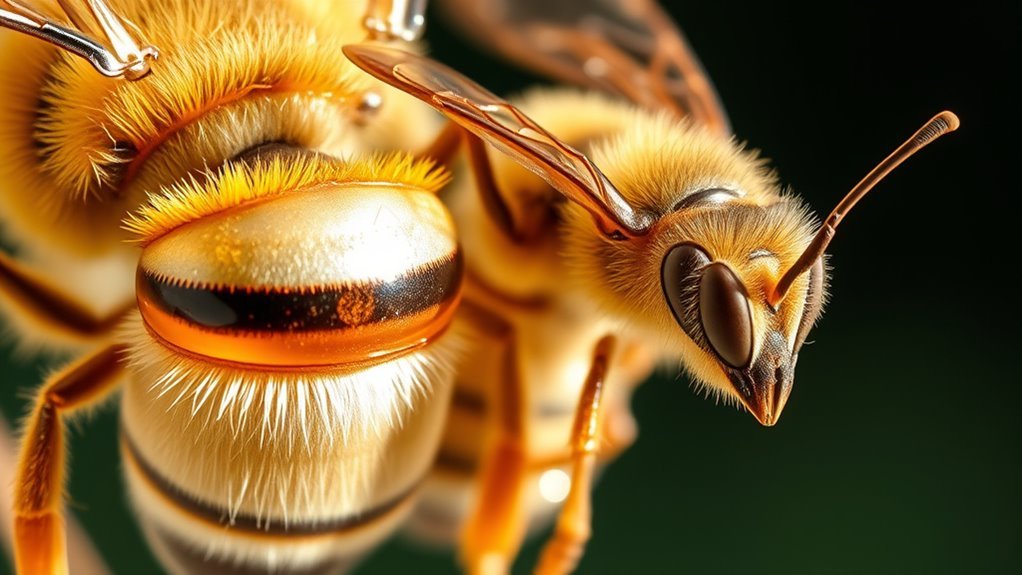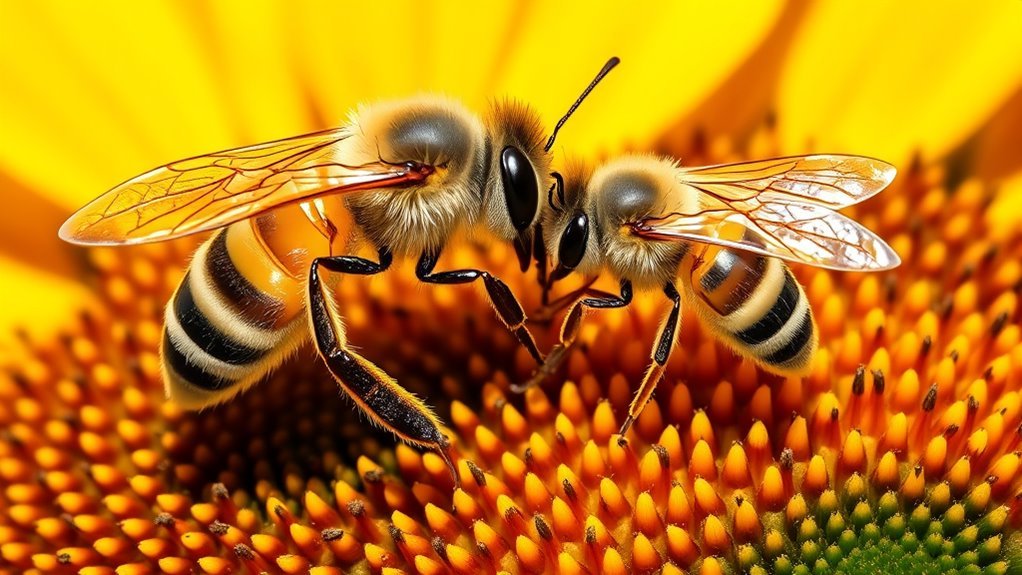Drone bees differ greatly from worker bees in their sting; worker bees have barbed stingers, enabling them to defend the hive, while drones lack stingers entirely. This distinction highlights the specialized roles within the colony, as worker bees focus on protection and foraging, while drones exist primarily for reproduction. The absence of stingers in drones minimizes risks during mating. If you explore further, you’ll uncover fascinating insights into these bees’ unique contributions to the hive and the ecosystem.
Understanding the Roles of Worker Bees and Drone Bees

While both worker bees and drone bees play essential roles in a hive’s ecosystem, their functions and responsibilities differ markedly. Worker bees, occupying the lower tiers of the bee hierarchy, engage in tasks such as foraging, nursing larvae, and maintaining hive cleanliness. They guarantee the colony’s survival and efficiency. In contrast, drone bees serve a singular purpose: reproduction. Their primary role is to mate with a queen during the mating flight, thereby facilitating genetic diversity within the hive. Unlike worker bees, drones don’t contribute to foraging or hive maintenance. This division of labor emphasizes the distinct reproductive roles within the hive, highlighting the intricacies of bee society and the specialized functions each type of bee fulfills to sustain the colony’s overall health and productivity.
Physical Characteristics of Worker Bees vs. Drone Bees

When comparing worker bees and drone bees, you’ll notice distinct differences in body structure and wing size. Worker bees are generally smaller and more streamlined, equipped for various tasks like foraging and hive maintenance. In contrast, drones possess larger bodies and longer wings, optimized for flight during mating season.
Body Structure Differences
Although they both play essential roles within a hive, worker bees and drone bees exhibit distinct physical characteristics that reflect their specific functions. Worker bees possess a more compact body composition, featuring a narrower waist and specialized anatomical features like pollen baskets on their hind legs, aiding in foraging tasks. In contrast, drones are larger and bulkier, equipped with a more rounded abdomen that houses reproductive organs. This difference in body structure is crucial for their roles; workers focus on hive maintenance and foraging, while drones’ primary purpose is to mate with the queen. Understanding these anatomical features not only highlights their roles but also underscores the evolutionary adaptations that allow each type of bee to thrive in their respective functions.
Wing Size Variation
The wing size of worker bees and drone bees varies considerably, reflecting their differing roles within the hive. Worker bees possess shorter wings, around 8 to 10 mm in length, which enhances their maneuverability and aerodynamic efficiency during foraging and hive maintenance. In contrast, drone bees have longer wings, typically measuring 11 to 12 mm, enabling them to fly more efficiently over greater distances. This adaptation supports their primary function: mating with a queen. The longer wing length of drones, while beneficial for flight capabilities, also presents a trade-off in agility. Understanding these physical differences is essential for comprehending the distinct roles each bee plays in maintaining the hive’s health and productivity.
The Anatomy of Bee Stings

While many might associate bee stings solely with pain, understanding the anatomy of a bee sting reveals a complex structure designed for both defense and survival. The sting anatomy consists of a sharp, barbed structure that enables efficient penetration into potential threats. Its venom composition varies, containing proteins that induce pain and allergic reactions.
- An intricate design for effective defense
- A potent cocktail that can incapacitate
- The dual purpose of survival and protection
- A reminder of nature’s fierce beauty
- The delicate balance of life and death
Recognizing these elements not only fosters respect for bees but also emphasizes the intricate role they play in our ecosystem. Their stings are more than just pain; they’re a life-preserving mechanism.
Do Drone Bees Sting?
Drone bees, typically numbering in the thousands within a hive, do not possess the ability to sting. Unlike worker bees, which have developed stingers as a defense mechanism, drone bees lack this feature entirely. Their primary role is to mate with the queen, and they are designed solely for reproduction.
| Feature | Drone Bees | Worker Bees |
|---|---|---|
| Sting Ability | None | Yes |
| Primary Role | Mating | Foraging, Defense |
| Lifespan | Short (weeks) | Longer (months) |
This difference in sting ability emphasizes the distinct roles both types of bees play in the hive, highlighting the specialized nature of drone bees.
The Purpose of Stinging in Worker Bees
Worker bees utilize their stingers primarily as a defense mechanism to protect the colony from threats. This aggressive behavior guarantees the survival of the hive by deterring predators and rival insects. Understanding the purpose of stinging reveals the critical role worker bees play in maintaining colony integrity.
Defense Mechanism
Although the primary role of worker bees revolves around foraging and hive maintenance, their ability to sting serves as an essential defense mechanism. Your understanding of their sting capabilities can enhance your appreciation for their role in the ecosystem. Worker bees employ various defense strategies to protect their colony from threats:
- A painful sting deters predators, guaranteeing safety.
- Alarm pheromones signal distress, rallying nearby bees for support.
- The sting’s barbed structure guarantees it remains embedded, increasing its effectiveness.
- Multiple stings can incapacitate larger intruders.
- The act of stinging fosters a collective defense spirit, promoting unity.
In recognizing these defense mechanisms, you grasp the critical nature of worker bees’ stings, appreciating their commitment to safeguarding their hive.
Colony Protection
When a threat looms over the hive, the stinging behavior of worker bees becomes an important element in colony protection. These bees, integral to the colony hierarchy, communicate danger through pheromones, triggering a collective defensive response. The sting serves not only as a physical deterrent but also as a signal that galvanizes other workers into action. This coordinated effort reflects the intricate social structure within the hive, where each worker’s role is essential for survival. By effectively utilizing their stings, worker bees guarantee that potential threats are neutralized, maintaining the colony’s integrity. Consequently, the act of stinging transcends individual defense, becoming a significant mechanism for the collective security of the hive, reinforcing the bonds of cooperation among its members.
Survival Strategies of Drone Bees
While drone bees play an essential role in the reproductive cycle of a hive, their survival strategies are distinctly different from those of worker bees. Drones focus on mating strategies to guarantee genetic diversity within the colony. Their primary goal is to mate with a queen, which means they often venture outside the hive, exposing themselves to various dangers. Unlike workers, drones don’t defend the hive and rely on their size and flight agility for survival.
Drones prioritize mating for genetic diversity, embracing risks outside the hive while relying on agility for survival.
- They embrace freedom, soaring high in search of queens.
- Their existence hinges on a singular reproductive role.
- Drones face constant threats from predators.
- There’s a fleeting sense of purpose in their brief lives.
- They embody the delicate balance of life and death in nature.
The Life Cycle of Worker Bees and Drone Bees
Drones and worker bees have distinct life cycles that reflect their roles within the hive. Worker bees undergo various bee development stages, starting as eggs, then developing into larvae, pupae, and finally emerging as adults within about 21 days. Their primary reproductive role is to gather resources and maintain hive health. In contrast, drones are produced later in the season, emerging from eggs fertilized by the queen. Their life cycle spans approximately 24 days, emphasizing their singular reproductive role of mating with the queen. While workers contribute continuously to hive activities, drones exist primarily to guarantee genetic diversity. This division of labor illustrates the specialization that supports the hive’s survival and efficiency, aligning with each bee’s designated function.
How Environmental Factors Influence Bee Behavior
Although various environmental factors can markedly impact bee behavior, the most notable influences include temperature, humidity, and floral availability. Bees react dynamically to temperature fluctuations and their effects on pollen availability, which directly influences foraging patterns and hive activity. During warmer months, increased floral abundance encourages bees to extend their foraging hours, thereby enhancing hive productivity. Conversely, during colder periods, bees may become more inactive, affecting their overall health and survival rates.
- A sudden drop in temperature can halt foraging.
- Lack of pollen availability threatens hive stability.
- Humidity changes impact bee communication.
- Floral scarcity leads to competition among hives.
- Extreme weather events can displace entire colonies.
Understanding these factors helps you appreciate the delicate balance of nature that bees navigate daily.
The Importance of Both Bees in the Ecosystem
As you explore the essential roles that both drone bees and worker bees play in the ecosystem, you’ll find that each contributes uniquely to the health and stability of their environments. Worker bees are critical in pollination, facilitating the reproduction of flowering plants, which in turn sustains the food web. Their relentless foraging guarantees abundant pollination benefits, fundamental for crops and wild flora alike. Drones, while primarily focused on mating, contribute to genetic diversity within bee populations, promoting resilience against diseases and environmental changes. Together, these bees maintain ecosystem balance, guaranteeing a thriving habitat for various species. Understanding their roles underscores the necessity of conserving both types, as their disappearance could disrupt essential ecological functions.
Frequently Asked Questions
Can Drone Bees Defend the Hive Like Worker Bees Do?
Drone bees don’t defend the hive like worker bees do. Their primary role involves mating. While drone behavior focuses on reproduction, worker bees actively protect the colony, showcasing distinct hive roles essential for survival.
Do Drone Bees Have a Mating Season?
Yes, drone bees do have a mating season. Their mating behavior aligns with seasonal patterns, typically occurring in late spring to early summer, when environmental conditions are ideal for reproduction and attracting queens.
What Happens to Drone Bees After Mating?
Did you know that 90% of drone bees die shortly after mating? In the drone bee life cycle, their mating behavior culminates in a brief, intense moment, leading to their ultimate demise, ensuring genetic diversity.
How Do Worker Bees Care for Drone Bees?
In hive dynamics, worker bees maintain drone bees by providing food and care, reinforcing the bee hierarchy. They guarantee drones are well-nourished during the breeding season, highlighting their essential role in colony reproduction and survival.
Are There Any Benefits to Drone Bee Stings?
While you might think drone bee stings are like whispers in a storm, they’re actually non-functional due to drone bee anatomy. Their role focuses on reproduction, contributing to bee hive dynamics, not defense.

